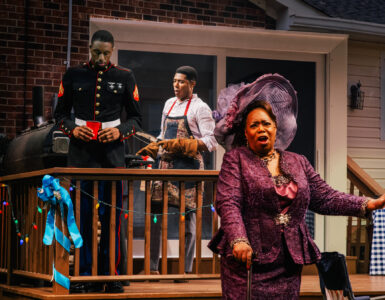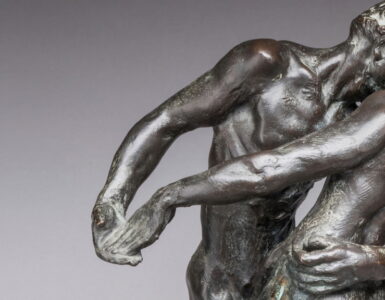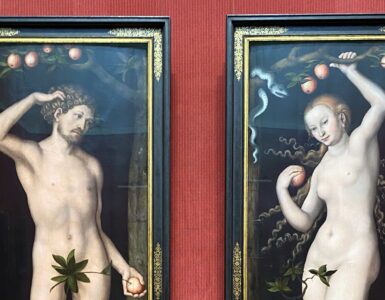
***
An absorbing, if rather scholarly, exhibition is currently being staged at the Getty Center by the Getty Research Institute. Display and Art History: The Dusseldorf Gallery and Its Catalogue illustrates the making of one of the earliest modern art catalogues, La galerie Electorale de Dusseldorff (1778); a revolutionary two-volume publication.
Review by Pauline Adamek
Featuring displays of large-scale etchings, reproductions of paintings and handsome books of etchings, as well as some of the actual paintings that were copied, this two-room exhibition gives fascinating insight into an important development in art history. In a large, central display cabinet you can see a scale model of the Dusseldorf Gallery with facsimiles of the art works as they were hung and displayed. Next to it is the first, handsome volume of the 1778 Catalogue, which contained the text and descriptions of the art works, and the second volume containing the prints.
This exhibition traces the development of a new type of picture gallery display and catalogue that emerged in the late 18th century. This new style of presenting works of art marked the transition in the history of the museum from the Baroque to the Enlightenment, and eventually led to the types of displays and catalogues that we see in museums today.
Between 1709 and 1714, Johann Wilhelm II von der Pfalz, a German prince, built one of the earliest European picture galleries next to his palace in Dusseldorf — the first example of housing an art collection in a separate structure adjoining the palace.
Johann Wilhelm’s nephew and successor, Carl Theodor, hired Lambert Krahe as director of the gallery in 1756. Krahe then broke with the Baroque tradition of covering an entire wall with paintings. Instead, he displayed paintings in a didactic, symmetrical arrangement ordered by schools of art creation, such as the Dutch school, the Flemish school and the Italian school, encouraging viewers to draw comparisons between the art works. Krahe’s enlightened display was a groundbreaking and modern system of organizing and displaying paintings.
The Dusseldorf catalogue produced by Nicolas de Pigage, Christian von Mechel, and Jean-Charles Laveaux represented Krahe’s display. Unlike earlier catalogues that only provided inventories, this new style of catalogue offered an analysis of each painting. The catalogue both served as a representation of princely magnificence and fostered art-historical education.
Constructed by Elector Palatine Johann Wilhelm II von der Pfalz between 1709 and 1714, the Dusseldorf gallery is an early example of exhibiting an art collection in a nonresidential structure. It charted the course toward what would eventually become the institution of the public museum. The Dusseldorf gallery featured a new system of display in which the arrangement of objects was determined by art historical principles such as style and school, rather than subject. Published in the second half of the eighteenth century, the Dusseldorf catalogue represented this new display in numerous etchings; the accompanying text sought to educate a broader circle of readers.

Display and Art History: The Dusseldorf Gallery and Its Catalogue, on view at the Getty Research Institute at the Getty Center through August 21, 2011, showcases the exquisite watercolors, red chalk drawings, and architectural elevations that were used to produce this revolutionary catalogue. The exhibition explores their role in the complicated and costly printmaking process and underscores their value as precious works of art created by accomplished draftsmen.
“We are most fortunate to have an almost complete set of preparatory drawings in our archives, which allows for the reconstruction of this ambitious enterprise and reflects a pivotal moment in the history of art as well as the history of the art museum,” says Thomas Gaehtgens, Director of the Getty Research Institute.
Prince-elector Johann Wilhelm II assembled one of the most important European art collections of the eighteenth century. His gallery was constructed to exhibit his nearly 400 paintings, 46 of which were by Peter Paul Rubens. At the time, many princes were reorganizing their substantial collections in order to convey the message that they not only possessed a wide variety of artistic treasures but were also able to care for them properly and make them available for study.
A generation later, Prince-elector Carl Theodor von der Pfalz, Johann Wilhelm’s nephew and successor, commissioned Lambert Krahe, director of the Dusseldorf Academy and gallery, to rehang the paintings collection following its storage during the Seven Years’ War (1756-63). Krahe broke with the Baroque tradition of decoratively covering entire walls with paintings. Instead, he displayed the paintings in a didactic, symmetrical arrangement ordered by schools, thus introducing a completely new and modern system of organizing art. Rather than hanging paintings frame-to-frame, Krahe integrated space between them, preserving their identity as separate works of art. This new display encouraged viewers to draw comparisons.
The Dusseldorf catalogue similarly fostered learning and education, in addition to celebrating the prestige of the collector. Produced by court architect Nicolas de Pigage, printmaker Christian von Mechel, and linguist Jean-Charles Laveaux, the catalogue illustrates Krahe’s display of paintings on the gallery walls. Unlike earlier catalogues that only provided brief inventories, Pigage’s publication offers an analysis of each painting that was aimed at an educated public.
“In this sense, the catalog was very much a work of the Enlightenment, and the princely gallery, accessible to interested visitors, became more like a museum as we understand it today,” says Gaehtgens.
Louis Marchesano, the GRI’s Curator of Prints and Drawings, adds, “The catalogue no longer simply represented princely magnificence; it now also fostered aesthetic reflection and art historical education.”
Display and Art History is co-curated by Thomas Gaehtgens, Director of the Getty Research Institute, and Louis Marchesano, the GRI’s Curator of Prints and Drawings. They also co-authored an accompanying book, Display and Art History: The Dusseldorf Gallery and Its Catalogue.
***
Display and Art History: The Dusseldorf Gallery and Its Catalogue
Getty Research Institute at the Getty Center
Now through August 21, 2011.
The J. Paul Getty Trust is an international cultural and philanthropic institution devoted to the visual arts that includes the J. Paul Getty Museum, the Getty Research Institute, the Getty Conservation Institute, and the Getty Foundation. The J. Paul Getty Trust and Getty programs serve a varied audience from two locations: the Getty Center in Los Angeles and the Getty Villa in Malibu.
The Getty Research Institute is an operating program of the J. Paul Getty Trust. It serves education in the broadest sense by increasing knowledge and understanding about art and its history through advanced research. The Research Institute provides intellectual leadership through its research, exhibition, and publication programs and provides service to a wide range of scholars worldwide through residencies, fellowships, online resources, and a Research Library. The Research Library – housed in the 201,000-square-foot Research Institute building designed by Richard Meier – is one of the largest art and architecture libraries in the world. The general library collections (secondary sources) include almost 900,000 volumes of books, periodicals, and auction catalogues encompassing the history of Western art and related fields in the humanities. The Research Library’s special collections include rare books, artists’ journals, sketchbooks, architectural drawings and models, photographs, and archival materials.
Visiting the Getty Center
The Getty Center is open Tuesday through Friday and Sunday from 10 a.m. to 5:30 p.m., and Saturday from 10 a.m. to 9 p.m. It is closed Monday and major holidays. Admission to the Getty Center is always free. Parking is $15 per car, $10 after 5pm on Saturdays and for evening events throughout the week. No reservation is required for parking or general admission. Reservations are required for event seating and groups of 15 or more. Please call 310-440-7300 (English or Spanish) for reservations and information. The TTY line for callers who are deaf or hearing impaired is 310-440-7305. The Getty Center is at 1200 Getty Center Drive, Los Angeles, California
Additional information is available here.







